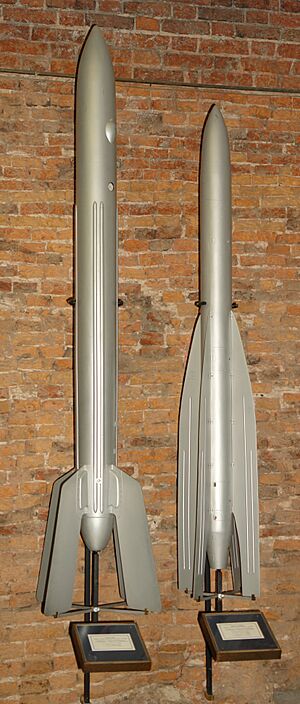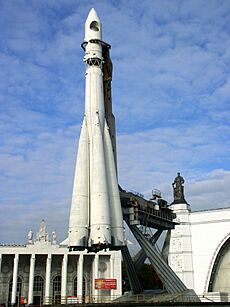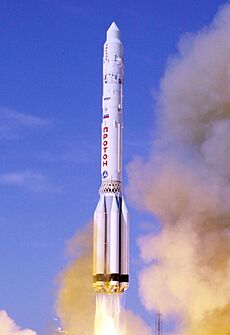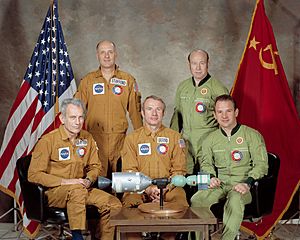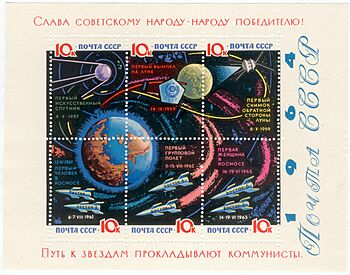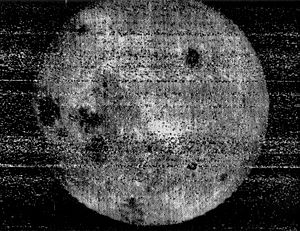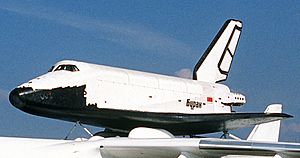Soviet space program facts for kids
| Космическая программа СССР Kosmicheskaya programma SSSR |
|
| Formed | 1955–1991 |
|---|---|
| Dissolved | November 14, 1991 |
| Manager |
|
| Key people | Design Bureaus |
| Primary spaceport | Cosmodrome Baikonur, Plesetsk |
| First flight | Sputnik 1 (October 4, 1957) |
| First crewed flight | Vostok 1 (April 12, 1961) |
| Last crewed flight | Soyuz TM-13 (October 2, 1991) |
| Successes | See accomplishments |
| Failures | See failures below |
| Partial failures | See partial or cancelled projects Soviet lunar program |
The Soviet space program (Russian: Космическая программа СССР, romanized: Kosmicheskaya programma SSSR) was the space program of the Soviet Union (USSR). It was active from 1955 until the country broke apart in 1991. Unlike space programs in America or Europe, the Soviet program was run by several competing design groups. These groups were led by brilliant engineers like Sergei Korolev, Valentin Glushko, and Vladimir Chelomey. The Soviet space program was very important for the Soviet Union to show its power to the world.
The Soviet Union started looking into rockets in 1921. These efforts grew a lot during the 1930s and 1940s. After World War II, both the Soviet Union and the United States used German rocket technology to help their early space efforts. In the 1950s, the Soviet program became official under Sergei Korolev. He was inspired by Konstantin Tsiolkovsky, often called the "father of theoretical astronautics."
The Soviet space program competed in the Space Race with the United States. It set many records in space exploration. These included launching the first satellite, Sputnik 1, in 1957. It also sent the first animal, a dog named Laika, into orbit that same year. In 1961, Yuri Gagarin became the first human in space. The program also sent the first woman, Valentina Tereshkova, into space in 1963. In 1965, the first spacewalk happened.
Other big achievements included robotic missions to the Moon starting in 1959. The Soviet program was the first to reach the Moon's surface. It also took the first picture of the far side of the Moon. It achieved the first soft landing on the Moon and deployed the first space rover, Lunokhod. In 1970, a robotic probe, Luna 16, brought Moon soil back to Earth. The Soviets also sent the first probes to Venus and Mars. They successfully landed probes on these planets in the 1960s and 1970s. In 1971, they put the first space station, Salyut 1, into orbit. The first modular space station, Mir, was launched in 1986. The Interkosmos program also sent the first person from a country other than the US or Soviet Union into space.
Contents
Early Steps in Space
Rocket Ideas and Pioneers
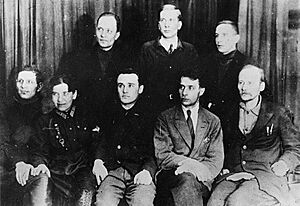
The idea of space travel was strong in Russia even before World War I. Russian scientist Konstantin Tsiolkovsky (1857–1935) wrote important papers on rockets and space theory. He figured out the Rocket equation and, in 1929, thought of using multi-stage rockets. Another engineer, Yuri Kondratyuk, came up with the idea of a lunar orbit rendezvous (LOR). This was a key idea for landing on the Moon and returning to Earth. It was later used for the first human Moon landing. Friedrich Zander, a Latvian rocket pioneer, suggested using the gravity of planets' moons to speed up or slow down spacecraft. This method is now called gravity assist.
First Rocket Developments
The first Soviet rocket work began in 1921. The military started a small lab to study solid fuel rockets. It was led by Nikolai Tikhomirov, a chemical engineer. In 1928, the lab was renamed the Gas Dynamics Laboratory (GDL). They test-fired a solid fuel rocket in March 1928, which flew about 1,300 meters. Later, in 1932, RS-82 missiles were successfully test-fired from an airplane.
A young Russian aircraft engineer, Sergey Korolev, became very important to early Soviet efforts. He later became the main leader of the Soviet space program. In 1930, he became interested in using liquid-fueled rocket engines for airplanes. This led him to work with Zander and sparked his interest in space.
GIRD and Early Rockets
Practical rocket experiments were done by the 'Group for the Study of Reactive Motion' (GIRD) in the 1930s. Zander, Korolev, and other engineers worked together there. On August 18, 1933, GIRD launched the first hybrid propellant rocket, the GIRD-09. On November 25, 1933, they launched the Soviet Union's first liquid-fueled rocket, GIRD-X.
Reactive Scientific Research Institute (RNII)
In 1933, GIRD and GDL joined to form the Reactive Scientific Research Institute (RNII). This brought together the best rocket minds, including Korolev and Glushko. RNII had early successes like the RP-318, the first Soviet rocket-powered aircraft, in 1941. They also developed the Katyusha rocket launcher, a famous multiple rocket launcher used in World War II.
However, in the 1930s, political problems in the Soviet Union slowed down rocket progress. Many top engineers, including Korolev and Glushko, were arrested or imprisoned. Korolev was later moved to a special prison for scientists.
World War II and German Influence
During World War II, rocket work continued in three Soviet design groups. They kept improving solid fuel rockets like the Katyusha. They also developed rocket-powered interceptor aircraft.
After World War II, Nazi Germany had very advanced rocket technology. Both the Soviet Union and the United States rushed to get this technology. Soviet rocket experts went to Germany in 1945 to study V-2 rockets. They worked with German specialists to understand and copy the rockets. This German help was very valuable in the beginning. However, after 1947, the Soviets mostly relied on their own scientists and engineers.
The Space Race Begins
Sputnik and Vostok Achievements

The Soviet space program was closely linked to the country's military plans. Korolev dreamed of space travel, but he kept it quiet while working on military rockets. After the Soviet Union tested its first atomic bomb in 1949, they needed a rocket to carry a nuclear warhead to the United States. This rocket, the R-7, was also perfect for launching things into space.
In July 1955, the United States announced its plan to launch a satellite. This helped Korolev convince Soviet leader Nikita Khrushchev to support his space plans. Korolev said they needed to launch a "simple satellite" to compete with America. Plans were approved for Earth-orbiting satellites called Sputnik. They also planned for a human spaceflight and a robotic mission to the Moon.
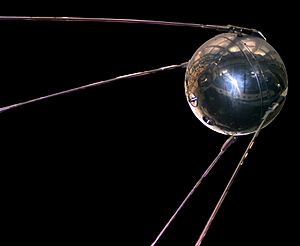
Sputnik 1 launched on October 4, 1957. It was a huge success and a big propaganda win for the Soviets. Korolev, now known only as the "Chief Designer," was told to speed up the human space program. The design for human spacecraft was combined with military spy satellites to create the Vostok spacecraft. After Sputnik, Soviet scientists wanted to build a human space station to study how zero-gravity affects living things. Korolev even made plans for human trips to Mars as early as 1968. These plans were much more ambitious than America's goal of landing on the Moon.
Funding and Support
The Soviet space program received less military money than the rockets designed to carry nuclear weapons. Even though the Soviet leader Khrushchev had a close relationship with Korolev, he cared more about missiles than space exploration. He wasn't very interested in competing with America's Apollo program.
The government used space successes for propaganda, but missions were rarely planned just for political reasons. One exception was sending Valentina Tereshkova, the first woman in space, on Vostok 6 in 1963. Missions were often planned based on which rockets were available. For example, in February 1962, the government suddenly ordered two Vostok spacecraft to launch at the same time to beat John Glenn's flight. The program couldn't do it until August with Vostok 3 and Vostok 4.
Competition and Challenges
Unlike the American space program, which had one main agency (NASA), the Soviet program was split among several competing design groups. Even after the successes of the Sputnik program (1957-1961) and Vostok programme (1961-1964), Korolev's design bureau faced more and more competition. Korolev wanted to build the Soyuz spacecraft and the huge N1 rocket. These would be used for a permanent human space station and for exploring the Moon. However, he was told to focus on missions closer to Earth and robotic missions to Venus and Mars.
Other chief designers, like Mikhail Yangel, Valentin Glushko, and Vladimir Chelomei, also had their own ideas and projects. This competition sometimes slowed things down. The progress of America's Apollo program worried the Soviet designers. They all pushed for their own projects as the best way to respond. Many different designs were approved, and new ideas often threatened projects already underway.
Finally, in August 1964, the Soviet Union decided to seriously compete for the Moon. They aimed for a lunar landing in 1967 or 1968. In 1961, a cosmonaut named Valentin Bondarenko died in a fire during a training experiment. The Soviet Union kept his death a secret and continued with the space program.
After Korolev's Time
Korolev died in January 1966 after surgery. Kerim Kerimov took over as the head of human spaceflights for the next 25 years. He oversaw the development of human spacecraft and robotic probes. One of his biggest achievements was launching the Mir space station in 1986.
Vasily Mishin took over Korolev's design bureau. His job was to send a human around the Moon by 1967 and land one by 1968. Mishin didn't have Korolev's political power and still faced competition. Under pressure, Mishin approved the launch of Soyuz 1 in 1967, even though it hadn't been tested without a crew. The spacecraft crashed, killing cosmonaut Vladimir Komarov. This was the first time someone died during a space mission.
The Soviets kept trying for a Moon mission with the huge N-1 rocket. But it exploded shortly after launch in all four uncrewed tests. The Americans won the race to land humans on the Moon with Apollo 11 on July 20, 1969.
In 1971, the Soyuz 11 mission to the Salyut 1 space station ended tragically. Three cosmonauts died when their re-entry capsule lost air pressure on the way back to Earth. This was the only time people have died in space itself (beyond 100 km altitude). After this, Mishin was removed from many projects. In 1974, the N-1 rocket program was canceled, and Mishin left his position. Valentin Glushko became the new chief designer.
Even though the human Moon program failed, the Soviet Union had great success with robotic Moon missions. They achieved the first robotic rover on the Moon (Lunokhod) and the first robotic sample return from the Moon. They also had success with probes to Venus and Mars.
After the Soviet Union broke apart in 1991, Russia took over most of the space program. Ukraine also received some facilities. The main spaceport, Baikonur Cosmodrome, is now in Kazakhstan, which leases it to Russia.
Program Secrecy
The Soviet space program kept its projects very secret, even before the success of Sputnik. When Sputnik was approved, the government immediately thought about what to tell the world.
Official announcements about the Soviet space program didn't give many details. They didn't say who built or launched the satellites. The public releases had lots of scientific data but no pictures. They mostly showed pride in Soviet space achievements and hinted at future possibilities.
The secrecy helped prevent other countries from getting classified information. It also created a mysterious feeling around the program for the Soviet people. Launches were not announced until they happened. Cosmonaut names were not released until they flew. Mission details were very limited. Outside observers didn't know the size or shape of their rockets or spacecraft.
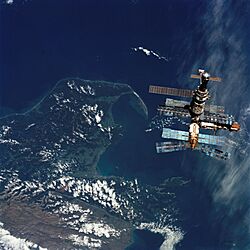
The military's influence on the program was a big reason for this secrecy. Soviet defense factories were given numbers instead of names. Even these internal codes were hidden. In public, employees used special post-office numbers to refer to factories and departments.
Public announcements from the program were always positive. As far as the people knew, the Soviet space program never failed. Historian James Andrews noted that news about Soviet space missions almost never mentioned problems or failures.
Projects and Accomplishments
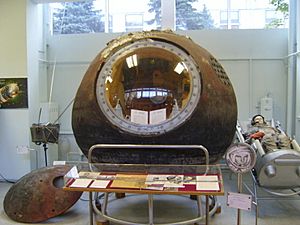
Completed Projects
Here are some of the Soviet space program's projects:
- Almaz space stations
- Cosmos satellites
- Luna – Missions to the Moon (flybys, orbiters, landers, rovers, sample returns)
- Mars probe program
- Mir space station
- Salyut space stations
- Soyuz program spacecraft
- Sputnik satellites
- Venera – Probes to Venus
- Vega program – Probes to Venus and Halley's Comet
- Vostok program spacecraft
- Voskhod program spacecraft
- Zond program
Notable Firsts in Space
On July 31, 1955, two days after the United States announced its satellite plans, the Soviet Union announced its own. Sputnik 1 launched on October 4, 1957, surprising the world.
The Soviet space program achieved many "firsts" in space exploration:
- 1957: First intercontinental ballistic missile and orbital launch rocket, the R-7 Semyorka.
- 1957: First satellite, Sputnik 1.
- 1957: First animal in Earth orbit, the dog Laika on Sputnik 2.
- 1959: First object to escape Earth's gravity, Luna 1.
- 1959: First data sent to and from space, Luna 1.
- 1959: First object to pass near the Moon and orbit the Sun, Luna 1.
- 1959: First probe to hit the Moon, Luna 2.
- 1959: First images of the Moon's far side, Luna 3.
- 1960: First animals to safely return from Earth orbit, dogs Belka and Strelka on Sputnik 5.
- 1961: First probe launched to Venus, Venera 1.
- 1961: First person in space and Earth orbit, Yuri Gagarin on Vostok 1.
- 1961: First person to spend over 24 hours in space, Gherman Titov, Vostok 2.
- 1962: First dual human spaceflight, Vostok 3 and Vostok 4.
- 1962: First probe launched to Mars, Mars 1.
- 1963: First woman in space, Valentina Tereshkova, Vostok 6.
- 1964: First multi-person crew (3 people), Voskhod 1.
- 1965: First spacewalk (EVA), by Alexsei Leonov, Voskhod 2.
- 1965: First probe to hit another planet (Venus), Venera 3.
- 1966: First probe to soft land on the Moon and send back data, Luna 9.
- 1966: First probe in lunar orbit, Luna 10.
- 1966: First image of the whole Earth from space, Molniya 1.
- 1967: First uncrewed rendezvous and docking in space, Cosmos 186/Cosmos 188.
- 1968: First living beings to reach the Moon and return safely, tortoises on Zond 5.
- 1969: First docking between two human spacecraft in Earth orbit and crew exchange, Soyuz 4 and Soyuz 5.
- 1970: First soil samples automatically taken from another celestial body and returned to Earth, Luna 16.
- 1970: First robotic space rover, Lunokhod 1 on the Moon.
- 1970: First successful soft landing and data transmission from the surface of another planet (Venus), Venera 7.
- 1971: First space station, Salyut 1.
- 1971: First probe to land on Mars, Mars 3.
- 1975: First probe to orbit Venus, land on Venus, and send photos from its surface, Venera 9.
- 1980: First Asian person in space, Pham Tuan; and first Latin American and person of African ancestry in space, Arnaldo Tamayo Méndez.
- 1984: First Indian astronaut in space, Rakesh Sharma.
- 1984: First woman to walk in space, Svetlana Savitskaya.
- 1986: First crew to visit two separate space stations (Mir and Salyut 7).
- 1986: First probes to deploy robotic balloons into Venus's atmosphere and take pictures of a comet, Vega 1, Vega 2.
- 1986: First permanently human-crewed space station, Mir (1986–2001).
- 1987: First crew to spend over one year in space, Vladimir Titov and Musa Manarov on Mir.
- 1988: First fully automated flight of a spaceplane (Buran).
Incidents, Failures, and Setbacks
Accidents and Cover-ups
The Soviet space program had several fatal accidents and failures. On March 23, 1961, cosmonaut Valentin Bondarenko died in a fire during a training exercise. On April 23, 1967, Soyuz 1 crashed due to a parachute problem, killing Vladimir Komarov. This was the first death during a space mission. The Soviets kept trying for the first Moon mission with the huge N-1 rocket. But it exploded shortly after launch in all four uncrewed tests. The Americans won the race to land humans on the Moon in July 1969. In 1971, the Soyuz 11 mission to the Salyut 1 space station ended with the deaths of three cosmonauts. Their re-entry capsule lost air pressure as they prepared to return to Earth. This was the only time humans have died in space itself. On April 5, 1975, a Soyuz rocket carrying two cosmonauts had a problem during launch. The escape system worked, saving the cosmonauts. They landed far away and were injured. On March 18, 1980, a Vostok rocket exploded on its launch pad during fueling, killing 48 people. In September 1983, a Soyuz rocket exploded on the launch pad. The escape system saved the two cosmonauts on board.
Buran Spaceplane
The Soviet Buran program tried to create its own spaceplanes, similar to the US Space Shuttle. These were launched by the powerful Energia rocket. Buran was designed to support large military platforms in space. It looked like the US Space Shuttle but had some differences. For example, Buran could land by itself without a pilot. By the time Buran was ready to fly in 1988, treaties to reduce weapons made it less important. On November 15, 1988, Buran and its Energia rocket launched, orbited twice, and then landed automatically. After this test flight, the program was stopped because it was too expensive and no longer needed.
Polyus Satellite
The Polyus satellite was a test version of a space weapon. It was designed to destroy enemy satellites using a powerful laser. It launched upside-down on its Energia rocket. Its only test flight failed when its navigation system spun it around too much.
Canceled Projects
Energia Rocket
The Energia was a very powerful rocket that used liquid hydrogen fuel. It was successfully developed. But without the Buran or Polyus satellites to launch, it was also canceled when the Soviet Union broke apart due to lack of money.
Unfinished Interplanetary Missions
Some ambitious missions to other planets were planned but never happened:
- A large rover called Mars 4NM was planned to launch to Mars between 1974 and 1975 using the N1 rocket.
- A mission to bring Mars soil samples back to Earth, Mars 5NM, was planned for 1975 using the N1.
- Another Mars sample return mission, Mars 5M, was planned for 1979.
- The Vesta mission would have sent two probes to fly by Mars and study asteroids in 1991.
- The Tsiolkovsky mission was planned for the 1990s. It would have sent a probe to fly by Jupiter and then pass very close to the Sun.
Images for kids
-
A replica of Sputnik 1.



